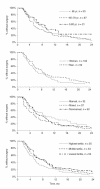The wait for total hip replacement in patients with osteoarthritis
- PMID: 17550712
- PMCID: PMC2384274
The wait for total hip replacement in patients with osteoarthritis
Abstract
Objectives: We documented the following components of waiting time for total hip replacement (THR): first surgical consultation, date of decision to operate and date of surgery. We then explored whether these intervals differed by age, sex, occupation or quality-of-life score.
Methods: We used a cross-sectional design and collected the primary data from patients 2 to 4 weeks before they underwent THR. Trained interviewers administered the Medical Outcomes Study Short Form-36 and the Western Ontario and McMaster Universities Osteoarthritis Index (WOMAC), which included data on event dates, conservative treatment, demographic information and quality of life. We illustrated waiting times, quality of life and past use of conservative treatment (i.e., cane, exercise, physiotherapy) with descriptive statistics (mean [standard deviation] or median [intraquartile range]) for continuous variables and with percentages for categorical variables. We plotted KaplanMeier graphs for each waiting time component and employed log-rank analysis to determine whether any of these delays differed by age, sex, occupation or disability. We also performed a Cox regression to adjust for all covariates simultaneously.
Results: The median wait from surgical consultation to decision to operate was 0 months. There was no difference between age, sex or occupation. The median wait from decision to operate to the date of surgery was 6 months and did not differ by age, sex or occupation. However, subjects with more severe symptoms (WOMAC) underwent surgery earlier than did those with less severe disease.
Conclusion: Although neither of the waiting time components were associated with age, sex or occupation, patients with more severe symptoms appear to be prioritized for surgery.
Objectifs: Nous avons documenté les éléments constituants suivants des temps d'attente dans le cas de l'arthroplastie totale de la hanche (ATH) : première consultation du chirurgien, date de la décision d'opérer et date de l'intervention chirurgicale. Nous avons ensuite cherché à déterminer si ces intervalles différaient selon l'âge, le sexe, l'occupation ou l'indice de la qualité de vie.
Méthodes: Nous avons utilisé un concept transversal et recueilli les données principales des patients deux à quatre semaines avant l'ATH. Des intervieweurs dûment formés ont administré la formule abrégée du questionnaire sur l'état de santé à 36 questions (Medical Outcomes Study Short Form-36) et l'indice Western Ontario et McMaster sur l'arthrose (WOMAC), qui comprennent des données sur les dates des événements, le traitement conservateur, les caractéristiques démographiques et la qualité de vie. Nous avons illustré les temps d'attente, la qualité de vie et le recours antérieur à un traitement conservateur (c.-à-d. canne, exercice, physiothérapie) au moyen de statistiques descriptives (moyenne [écart type] ou médiane [intervalle intraquartile]) pour les variables continues et des pourcentages pour les variables catégoriques. Nous avons tracé des courbes de Kaplan–Meier pour chaque élément constituant des temps d'attente et utilisé le test Mantel-Haenszel pour déterminer si un de ces temps différait selon l'âge, le sexe, l'occupation ou l'incapacité. Nous avons aussi procédé à une régression de Cox afin d'effectuer un rajustement pour toutes les covariables simultanément.
Résultats: Le temps d'attente médian entre la consultation du chirurgien et la décision d'opérer était de zéro mois. Il n'y avait aucune différence selon l'âge, le sexe ou l'occupation. Le temps d'attente médian entre la décision d'opérer et la date de l'intervention chirurgicale était de six mois et ne présentait aucune différence selon l'âge, le sexe ou l'occupation. Les sujets qui avaient des symptômes plus sévères (WOMAC) ont toutefois subi l'intervention chirurgicale plus rapidement que ceux dont l'état était moins grave.
Conclusion: Même si l'on n'a pas établi de lien entre aucun des éléments constituants des temps d'attente et l'âge, le sexe ou l'occupation, on a semblé accorder, pour procéder à l'intervention chirurgicale, la priorité aux patients qui avaient des symptômes plus sévères.
Figures




Comment in
-
Citations and wait-lists: much ado about nothing?Can J Surg. 2007 Apr;50(2):94-5. Can J Surg. 2007. PMID: 17550710 Free PMC article. No abstract available.
References
-
- Pageau M, Choinière R, Ferland M, Sauvageau Y. Le portrait de santé: le Québec et ses régions. Édition 2001. Quebec: Publications du Québec; 2001.
-
- Zelder M, Wilson G. Waiting your turn (10th ed): hospital waiting lists in Canada. Vancouver: The Fraser Institute; 2000.
-
- Badley EM. The Effect of osteoarthritis on disability and health care use in Canada. J Rheumatol Suppl 1995;43:19-22. - PubMed
-
- Badley EM, Wang PP. The contribution of arthritis and arthritis disability to nonparticipation in the labor force: a Canadian example. J Rheumatol 2001;28:1077-82. - PubMed
Publication types
MeSH terms
LinkOut - more resources
Full Text Sources
Medical
Miscellaneous
